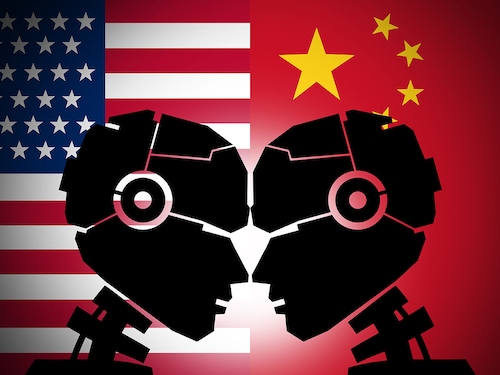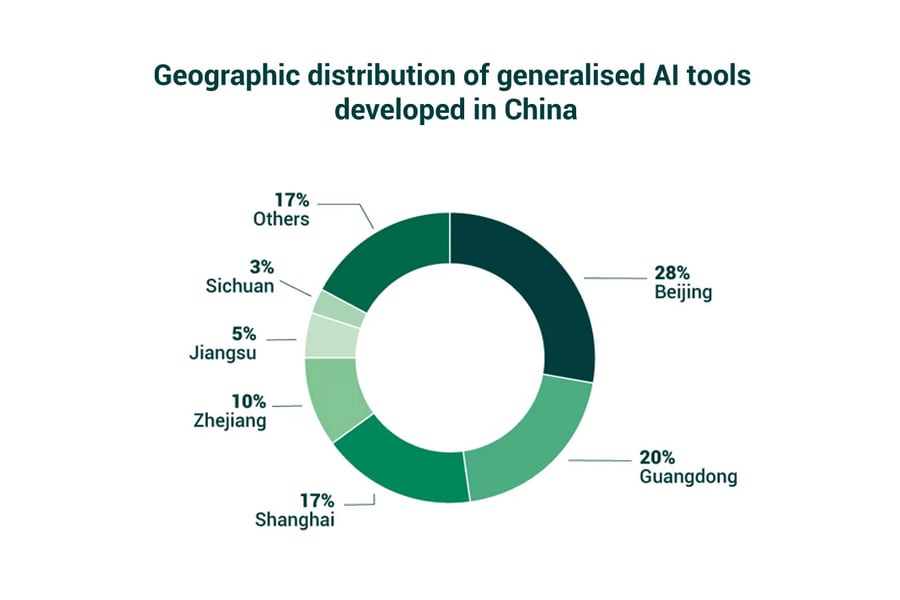The AI race through a geopolitical lens
A new world order is unfolding as the US-China AI race meets geopolitics


When a rising power meets with an established one, it inevitably leads to conflict. Is the Thucydides trap indeed playing out on the world stage, as the United States continues to guard its global technological lead – among other areas of dominance – against China’s ambitions?
What can history tell us about China’s ambitions? From Mao Zedong’s “Raise China" to Deng Xiaoping’s “Rich China", President Xi Jinping’s dream to “Restore China" as a global power is a preamble to the country’s quest for techno-strategic dominance.
Well aware that its chip ecosystem advantage is also China’s greatest vulnerability, the US is restricting chip exports to China to not only curtail its computing and data storage capabilities, but also dampen sectors from automobile to telecom, utilities, healthcare and military.
But the US’ export controls have only incentivised the Chinese to innovate, as the emergence of DeepSeek and Huawei’s new chips demonstrates. Are these game changers in the AI race?
AI is poised to be a general-purpose technology (GPT) with a broad range of applications across industries and sectors. Historically, the emergence of GPTs invariably led to the rise of a global superpower or heightened competition among superpowers. But how the race unfolds hinges not just on technological innovation diffusion capacity is pivotal.
Innovation capacity, as suggested by R&D spending, number of patents and scientific citations as well as investment, is mostly visible and measurable. As of 2024, the US has developed the largest number of notable AI models, spearheaded by Google, Meta, Microsoft and OpenAI. US tech giants invested US$300 billion in AI infrastructure in 2024, outpacing Chinese investments by six times. The US boasts superior infrastructure, maintaining 10 times more data centres than China and spending nearly four times more on AI servers.
That said, China has different cost dynamics. To stay ahead in the race, the capacity to deploy and integrate AI in the economy at scale is needed. In China, aggressive cloud pricing and open-weight models from DeepSeek and Alibaba have lowered barriers to entry and allowed SMEs to experiment with advanced AI at a fraction of the costs compared to the US.
Professor Weiru Chen from China Europe International Business School, who spoke at the INSEAD AI Forum Asia where I presented last month, illustrated China’s vibrant AI ecosystem. He pointed to Hangzhou’s “Six Little Dragons", tech giants such as Alibaba, Baidu, ByteDance, Huawei and Tencent, as well as a growing number of AI start-ups. At the same time, and perhaps unsurprisingly, 83 percent of all Chinese generative AI tools originated from six provinces, with the top three accounting for close to 50 percent of output.
 Fig 1: Generalised AI tools developed in China. Source: Trivium China, 2025
Fig 1: Generalised AI tools developed in China. Source: Trivium China, 2025
However, diffusion capacity is not always as apparent. It’s about the proportion of companies using AI the flow of talent between universities, R&D labs, start-ups, industry and government sectoral adoption rates links between frontier firms and application firms and the degree of competition.
Diffusion is taking place quietly but surely in China, thanks to its integrated digital foundations. Ubiquitous platforms such as WeChat and Alipay provide ready-made rails for AI deployment, bringing consumer receptivity that accelerates market penetration.
China’s AI ecosystem – marked by a lower cost structure and the availability of open-weight models – lowers barriers and enables rapid scaling and diffusion across consumer and industrial sectors. Moreover, less restrictive data access (compared to Western counterparts) enables faster iterations and development. The centralised government plays to China’s advantage, enabling a more coordinated approach to organising investment and resources, and to pivot where necessary. Moreover, the government’s adoption of AI sends demand signals to the market.
The flip side of this centralised approach is that the Chinese government’s concern with AI’s impact on society and use of censorship will slow down experimentation and throw sand in the innovation flywheel.
Ultimately, scale matters. To achieve scale, it takes investment, training data, talent and energy, but also the less tangible culture of experimentation, trust and excitement around the technology. The US government is planning an annual investment of US$165 billion into AI, four times that of the Chinese government at US$47 billion. The US boasts unmatched investments, a deep and distributed talent pool across academic, private and public institutions, and the market-driven integration of AI that facilitate effective implementation.
What the US lacks is the availability of energy and capacity to build quickly due to regulatory hurdles. Hence the agreement between the US and the United Arab Emirates to build what will eventually be a 5GW Stargate AI data centre in Abu Dhabi with 500,000 advanced Nvidia chips. On the other hand, China has the talent, training data, energy, as well as excitement.
The important question is: What is the destination of the race? Diffusion of GPTs takes time, and the productivity boost arising from them will not be immediately apparent. Studies show that when a new GPT is introduced, productivity initially falls and takes a long time to be translated into productivity gains.
For instance, it took three to four decades to see the productivity boost driven by the invention of electricity. For the internet, a sharp increase in productivity gains is very difficult to observe in the data. At the same time, there is evidence for productivity gains in the broader category of computing and for the US in ICT.
The holy grail for the US appears to be artificial general intelligence (AGI) – defined as AI with human-level intelligence that can rival human thinking – and even artificial super intelligence (ASI). If the US were to achieve AGI in the next three years or so, China would find it challenging to catch up.
On the other hand, China takes a pragmatic approach focused on application – much in line with its “Made in China 2025" strategy. Rather than pursuing AGI for the sake of it, it prioritises solving concrete problems, from manufacturing – think electric vehicles and solar panels – to healthcare. This means that it can yield real-world adoption and impact more quickly.
President Xi often speaks of the Thucydides trap this is clear for all to see. Then there is the lesser-known Kindleberger trap, where the superpower starts withdrawing and stops providing global public goods.
This can rock the international trading system, international monetary system, peacekeeping, freedom of movement and of navigation, and so on. The “trap" lies in how the emerging power is not willing to step up and provide these global public goods. This is reminiscent of the era just before World War II, when the United Kingdom pulled back but the US did not step up.
Apart from the lack of stability in international systems, there is a marked increase in skirmishes and conflict. This is materialising on the world stage, ranging from the more benign – think the US banning TikTok and China limiting Hollywood films – to the highly consequential, such as eye-watering tariffs by the US (temporarily paused), China’s critical mineral export controls and the US ban of Nvidia GPU exports to China.
Post-Trump America’s withdrawal from the world stage has also shaken the foundation of global military alliances – and it’s not just about dismantling NATO or ignoring international trading rules. The superpowers – past and present – are rethinking their spheres of influence, with the US targeting the Americas, Russia setting its eyes on Europe and China going for Asia.
At the confluence of the AI race and geopolitics, a new world order is unfolding.
First Published: Jun 20, 2025, 15:10
Subscribe Now